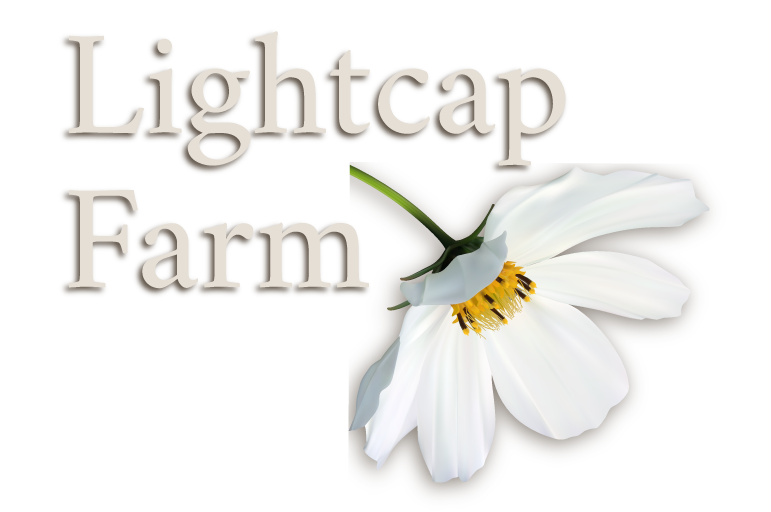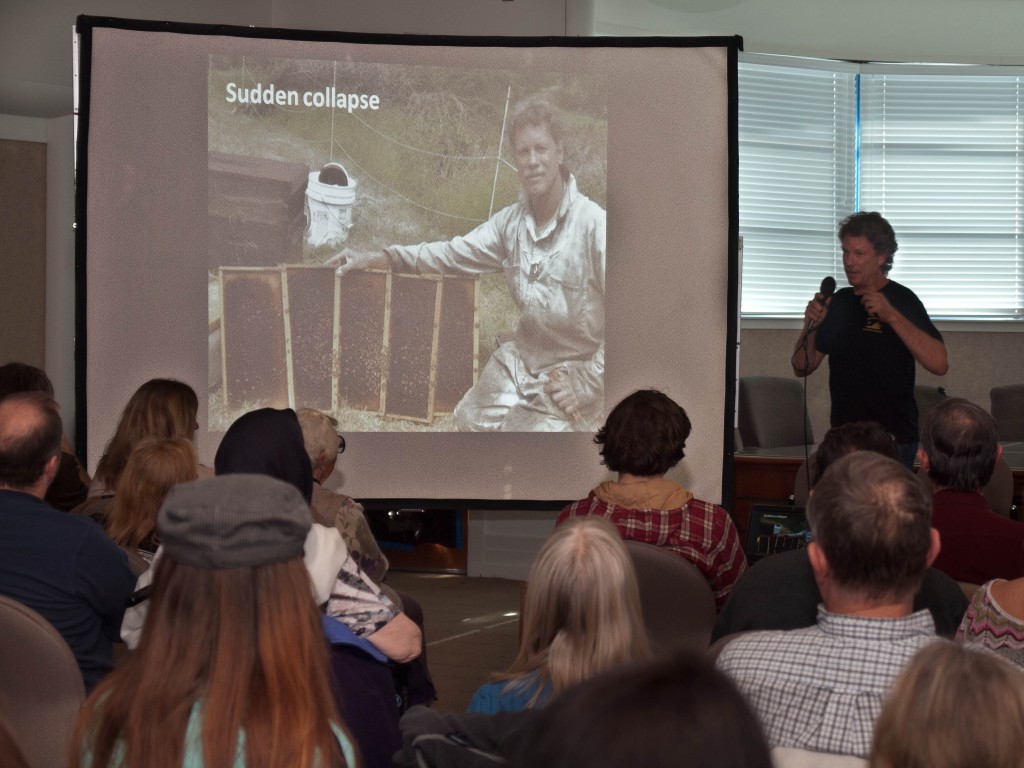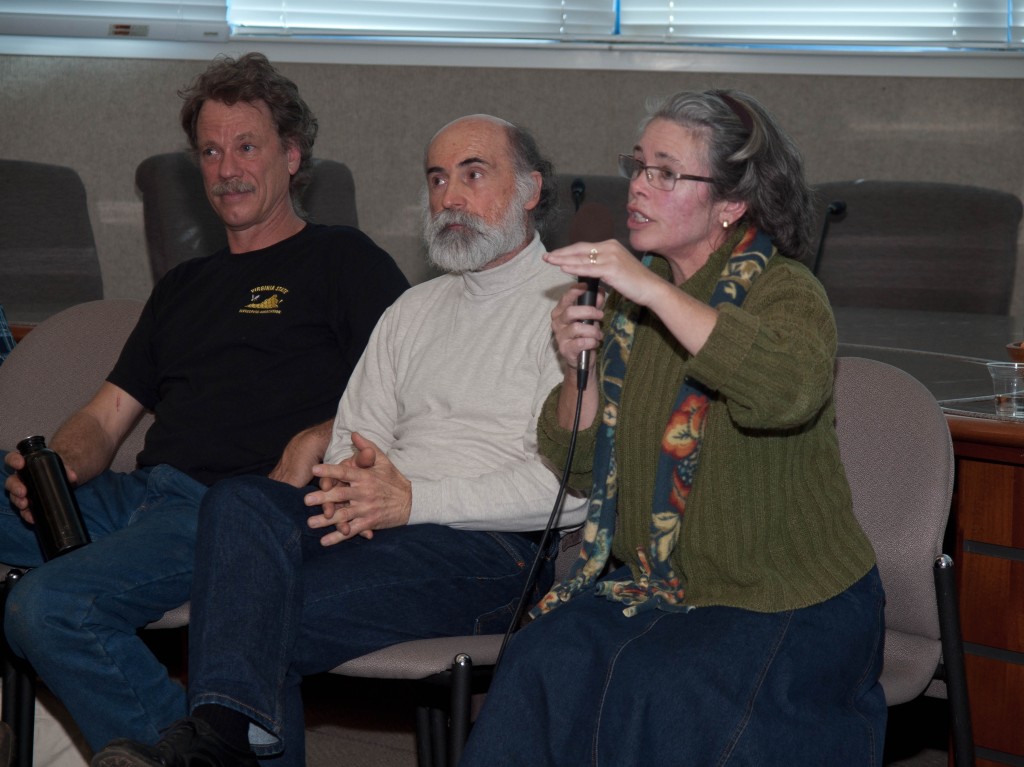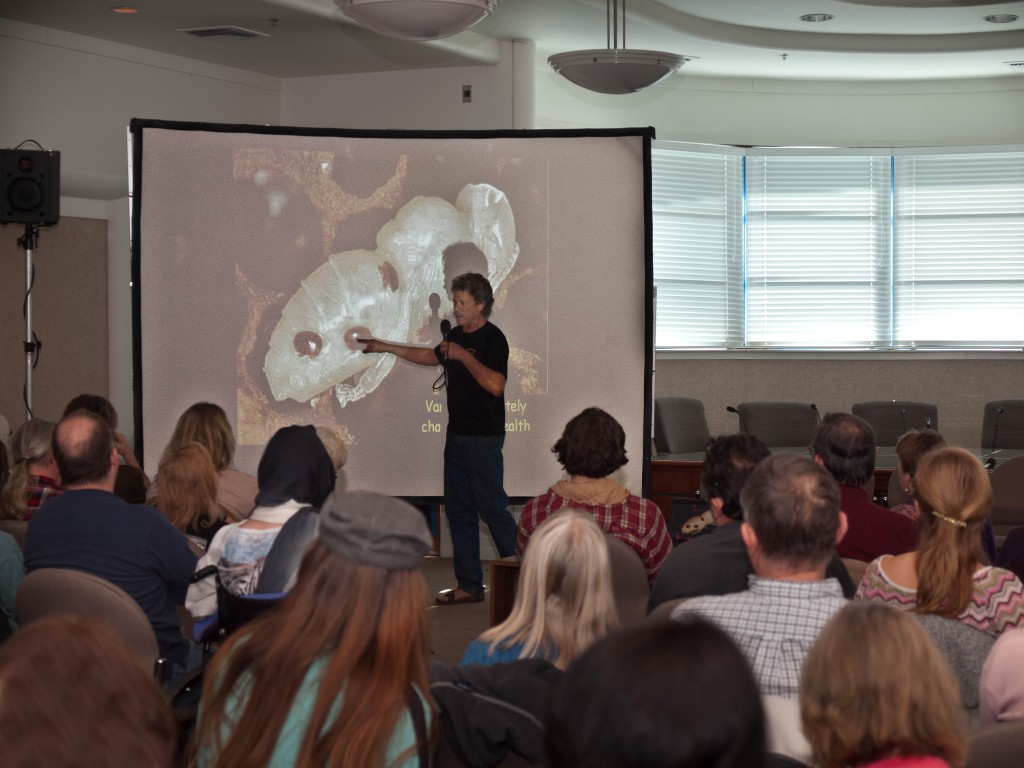Text by Carolyn Crane
Photos by Tony Finnerty
Nevada City, California
Last January 16, about a hundred people filled the meeting room in City Hall to participate in an activist workshop about the honeybee. The workshop, one of several at the Wild and Scenic Film Festival, featured five regional bee experts, including Randy Oliver. Oliver has achieved international recognition for his scientific approach to beekeeping. His specialty is to apply current scientific research to bee health problems, he says. He is “currently running his second FDA trial for a bee medicine here in Nevada County.”
That same weekend, Queen of the Sun: What Are the Bees Telling Us? screened at Wild and Scenic. This 2010 documentary canvasses the planet in search of answers to the widespread disappearance of bees. Featured prominently in the film is Midwestern beekeeper Gunther Hauk, whose life work with bees led him to create the Spikenard Farm Honeybee Sanctuary, an organization in Virginia that blends biodynamic farming with Waldorf education. For Hauk, the fate of bees and the fate of humans are so intertwined that “we could call it Colony Collapse Disorder of the human being, too.” Indeed, the two species may be irrevocably linked, since a significant percentage* of the food we consume, including fruits, vegetables, nuts, and oils, depends on the honeybee’s pollination for its survival.
Beekeepers often become poetic when discussing their passion. Queen of the Sun introduces many beekeepers who are, quite simply, in love with their bees. When beekeepers spoke at City Hall, their reverence for the bees was as evident as it is in the film. What is it about bees and people? In The Botany of Desire, Michael Pollan considers this question as he discusses the tulip and its pollinators, the bumble and honey bees. He quotes the poet and critic Frederick Turner: “ ‘The colors and shapes of the flowers are a precise record of what bees find attractive.’” It’s unusual, says Pollan, for insects and humans to have the same aesthetic sense. Flies, for instance, also key pollinators, are attracted to smells and sights that humans find repugnant. It may be that shared aesthetic that bonds us with the bees.
Randy Oliver seems different from most beekeepers. “I’m a scientist,” he says emphatically, and mentions that at times his conclusions can rankle those with less scientific approaches. What are Oliver’s hypotheses about what has come to be known as CCD? They are varied and cautious, and more or less in line with the theories posed in Queen of the Sun. What most people who study bees agree on is this: several factors are involved. We’ll look at the four principal factors, the first occurring about one hundred miles from here.
Factor #1: “The Bee Bordello”
Each spring, a significant percentage ** of the bees in the United States travel by truck to the California’s Central Valley to pollinate the blossoming almond orchards. “Without the almond growers and the high price we would never have survived,” commercial beekeeper Eric Olson stated in Queen of the Sun. Because of this mass migration, bees from all over the country converge, in effect climbing in bed together for a month of big fun. Michael Pollan, quoting a beekeeper, calls this the “bee bordello”. Oliver agrees, pointing out that any virus or mite a bee may bring from a certain region will immediately be spread to other regions when the bees return home. Add to the bordello factor the stress of travel and you get, in a manner of speaking, exhausted bees with scabies and STDs.

Randy Oliver illustrates the mass migration of honeybees to the Central Valley each February. Oliver takes his own bees there each year.
Factor #2: Monoculture
Why can’t the bees just live in the almond orchards all year? The answer is a one-word problem for bees: monoculture. Nearly a hundred years ago, Rudolph Steiner warned us that with increased mechanization and industrialization of agriculture would come the collapse of the beehive by the end of the 20th century. When a farmer plants only one crop, such as almonds or canola, the bees have nothing to eat once those blossoms die. A monoculture creates a desert for bees. “From the point of view of nature, it’s insane,” Michael Pollan says in Queen of the Sun. “Monoculture is the original sin of agriculture.”
Kathy Kellison is trying to do something about that. One of the five featured bee experts at City Hall that day, she’s founded Partners for Sustainable Pollination, which “collaborates with beekeepers, growers, and scientists to improve the health of honeybees and support native pollinators.” The organization’s Bee Friendly Farming campaign “educates consumers and encourages support for needed land management practices for healthy honey bees and thriving populations of native pollinators.” Kellison and others are calling on farmers to set aside at least 6% of their land and plant bee forage, creating a polyculture that will allow the land to sustain the bees and other insect species. However, some farmers are reluctant to reduce profits by removing a percentage of their market crop. The issue then turns down the political road of subsidies and lobbyists. In its role as an NGO, Kellison is hopeful that PFSP will make progress on that front.
Factor #3: Parasites
Parasites and bees have coexisted in the past, but in 1993 the varroa mite emerged on the scene and changed the face of beekeeping completely. The mite attaches to the bee in the hive, sucking its blood. According to Oliver, the varroa mite “is still by far the most serious problem to beekeeping in the U.S. and in Europe.” Beekeepers have experimented with many strategies in order to control the varroa mite. Local beekeeper Janet Brisson invented a special bottom screen for beehives that traps the varroa mite after powered sugar, sprinkled into the hive, forces the mite to leave the bee. This bottom board is used across the country. Recipes for organic compounds and home remedies are easily available on the Internet.
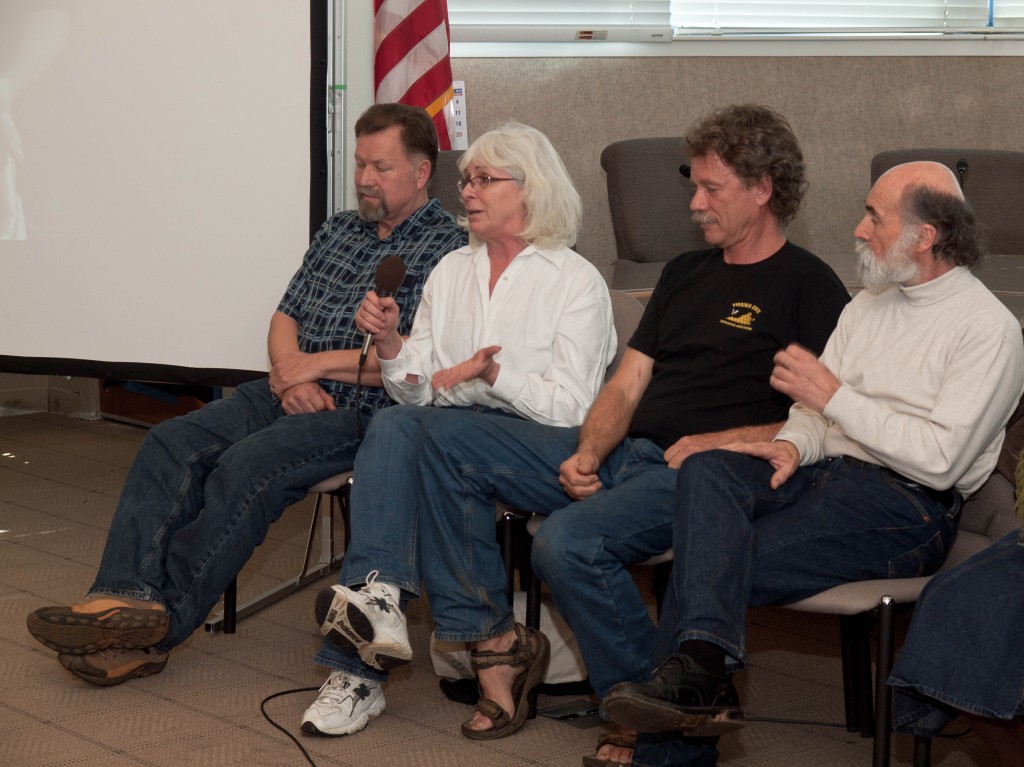
Nevada County’s Janet Brisson, inventor of the screen bottom board. With her, from left to right, fellow panelists Gary McClaughry, Randy Oliver, and Serge Labesque.
In Queen of the Sun, U.S. beekeeper Kirk Webster explains the problem of using chemicals to kill the mites: We are “breeding mites that adapt to every chemical,” he explains. One chemical, “formerly a deadly poison, [became] a resource” as the mites adapted to it. David Heaf, a Welsh biochemist turned beekeeper, is experimenting with allowing the varroa mite and the bee to “fight it out” in the hive. He feels beekeepers must get off the “treadmill of putting chemicals in hives”. Co-evolution between honeybee and mite, he believes, is the optimal outcome at this point. Oliver agrees, and has been selecting bees that exhibit mite resistance for eleven years. “There are quite a few beekeepers these days whose bees coexist with varroa without significant mortality,” he says. Beekeepers agree that if the bees are healthy, they might withstand the stress of the varroa mite. Other factors weaken the bee and make the parasite more deadly.
Factor #4: Herbicides and Pesticides
We don’t yet know the full extent of the effect of herbicides and pesticides on the honeybee. The proliferation of Monsanto’s genetically modified crops and their companion herbicide, Roundup, has altered a vast percentage of the honeybee’s landscape. This is because Roundup kills every plant but the genetically modified crop that is being grown, eliminating any forage for the honeybees once the crop has completed its bloom.
According to panelist Serge Labesque, the canola blossom is nearly the perfect food for the honeybee. In the film Percy Schmeiser: David versus Monsanto, we learn about the relationship between herbicides and genetically modified canola. Schmeiser states that Monsanto promised three things to the Canadian canola farmer in the mid 1990s: If they signed a contract with Monsanto and grew its genetically modified seed, they would always get a bigger yield, that yield would be more nutritious, and they would need to use fewer chemicals to produce it. “We found out the total opposite happened. We are now using more chemicals then ever before, and more powerful and more toxic chemicals.” According to the film, “even the Canadian government admits that GM canola is everywhere.” Despite this, Oliver says, “Canadian honeybees are thriving on GM canola. It has been quite a few years, and they don’t appear to have any problems.”
Experts disagree on the direct effect genetically modified plants have on the honeybee. In Queen of the Sun, Dr. Vandana Shiva and others offer scientific theory to support a direct causation. However, Randy Oliver turns to “independent scientific reports from a variety of sources”, and is emphatic that there is no scientific evidence to directly link genetic crop modification to CCD. What’s not in question, he says, is the effect of certain pesticides on the health of hives.
Ana Sofia Joanes, filmmaker and activist, is among those mounting a campaign against a pesticide used widely in the United States: clothianidin. In a recent email, Joanes states that the producer of the chemical is Bayer Crop Science, a German company: “This isn’t your usual pesticide—it’s applied to the seeds of plants themselves. It remains in the plant as it grows, and comes out through the plant’s pollen and nectar….The poison attacks the nervous system of bees and other insects, killing them off while having little effect on other animals. Already France, Italy, Slovenia and Germany have banned this pesticide from use on their crops—and their bee populations have bounced back.”
Randy Oliver does not at this time support a petition drive to ban clothianidin. In fact, he corrects Joanes: “Her statement is untrue. Clothianidin was briefly withdrawn form Germany, then reinstated when demonstrated to be safe. It is also currently registered in France and Italy.” He refers to the chemical as a neurotoxin, but says there is as of now insufficient science to support a U.S. ban. The EPA will not take the issue seriously until there is, he says, so the current grass roots movement headed by Joanes and others is not only a waste of time but damaging to beekeepers’ credibility. Oliver is negotiating with Bayer Crop Science and the EPA to conduct a field test with clothianidin here in Nevada County. The trial is not yet confirmed. If approved, the trial will “determine, without bias, if there are indeed any measureable effects of exposure to clothianidin. The results could support a ban, or put an end to the call for a ban,” he says.
“Colony Collapse Disorder is a bill we are getting for all we have done to the bees,” says Gunther Hauk. Despite the multitude of grave challenges that face the honeybee, that Sunday afternoon City Hall was abuzz with enthusiasm. Many hobby beekeepers were present, and the panel happily agreed—the more hives, the better. The Nevada County Bee Keepers Association provides an active and lively forum for the growing movement here. Queen of the Sun takes us to rooftop beekeepers around the world, and we watch city governments and activists teaching city dwellers that bees are a necessary part of their urban landscape. In The Botany of Desire, Michael Pollan asserts that plants have trained bees and people to care for them. The widespread resurgence of reverence for bees is a hopeful sign that Steiner’s prophecy may be narrowly averted.
#
* Experts disagree about this percentage. Michael Pollan says that about 40% of our food is pollinated by bees. Randy Oliver states that even 33% might be an exaggeration.
** Experts disagree about this percentage. Director Taggart Siegel reports in Queen of the Sun that 75% of the bees travel to the Central Valley. Randy Oliver says that it is only about half the managed colonies in the United States.
* * * * * * * *
You can follow Randy Oliver’s work at www.scientificbeekeeping.com. Partners for Sustainable Pollination’s website is http://pfspbees.org. You can learn more about Janet Brisson’s screen boards at www.countryrubes.com.
All photographs by Tony Finnerty. All rights reserved, used with permission.
The Quest for Local Honey sponsored the activist workshop at the 2011 Wild and Scenic Film Festival (www.questforlocalhoney.com). Both Queen of the Sun and Percy Schmeiser: David versus Monsanto screened at the festival. If you are a SRYCL member you can borrow copies of these films to view at home. For more information visit www.syrcl.org or www.wildandscenicfilmfestival.org.
